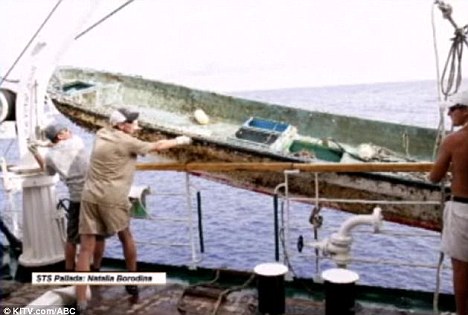Large black floats are the first remnants of Japan's devastating earthquake and tsunami to begin washing up on the American coastline.
The debris traveled 4,500 miles on Pacific Ocean currents, pushed by wind and water, to reach the beaches of Neah Bay in far northwestern Washington state 280 days after the Japanese disaster.
Some 100 million tons of debris — from wrecked fishing vessels to household furniture and even body parts — is bearing down on the West Coast, raising environmental fears about the impact of massive amounts of wreckage clogging beaches.

|
| Found: This large float made its way from Japan to Neah Bay, Washington, in about 280 days. Several have been found washed ashore in North America |
|
|

|
| Across the ocean: Currents and winds carried the floats across vast expanses of the Pacific Ocean |
The debris is even more massive and moving much faster than originally predicted. Initial projections said 5 to 20 million tons of waste would take three years to reach American shores.
Now, scientists say, 100 million tons could be here in just one year.
One float, the size of a 55-gallon drum, was found in Washington two weeks ago, another was reportedly discovered in Vancouver, Canada.
The 9.0 magnitude earthquake and ensuing tsunami that struck the eastern coast of Japan March 11 killed more than 15,000 people and washed homes, boats and human lives out to sea.
Anything that floated is now riding Pacific currents. According to computer predictions from the University of Hawaii, most of it is headed for an area between southern Alaska and southern California.
The researchers in Hawaii predicted most of the debris will reach the US mainland in three years.

|
| First arrivals: Oceanographer Jim Ingraham says the Japanese float is the first of millions of tons of debris likely to reach the shore |
|
|

|
| Pieces of Japanese life: All manner of debris was swept out to sea in the tsunami March 11 and is now headed for US coastlines |
However, oceanographers Curtis Ebbesmeyer and Jim Ingraham said some of the flotsam appears to be traveling much faster and could hit the West Coast in less than a year, the Peninsula Daily News reported.
Most debris travels at about 7 miles per day, the Seattle scientists said, but pieces can cover up to 20 miles in a day if they are big enough for the wind to push them.
The large black drums averaged about 16 miles per day to reach Neah Bay in Washington.
The University of Hawaii team also predicted the debris was about 5 to 20 million tons.
However Mr Ebbesmeyer and Ingraham say the errant Japanese flotsam could be five times that amount, about 100 million tons.
Sailors and the US Navy have spotted all manner of shards of Japanese life in the massive debris fields that are floating the currents.
In October, the crew of a Russian ship spotted televisions and refrigerators riding the current. Parts of homes, and a wrecked 20-foot fishing vessel have also been seen.

|
| Salvaged: Crew members of a Russian training ship pulled in a fishing boat from Japan that was found 2,000 miles out to sea |
|
|

|
| Massive wreckage: The debris field in the Pacific Ocean has been spread out in an area even larger than Japan itself |
Body parts are also expected to wash up on US shores, the Daily News reported.
The two researches said beachcombers who find any debris with identifying marks — such as Japanese writing — should contact authorities so it can be returned.
Families lost everything when their homes were washed away by the giant wall of water, Mr Ebbesmeyer said. Anything they can reclaim from the sea could help them recover from the disaster.
Copyright © 2011 Daily Mail
Reprinted for Fair Use Only.